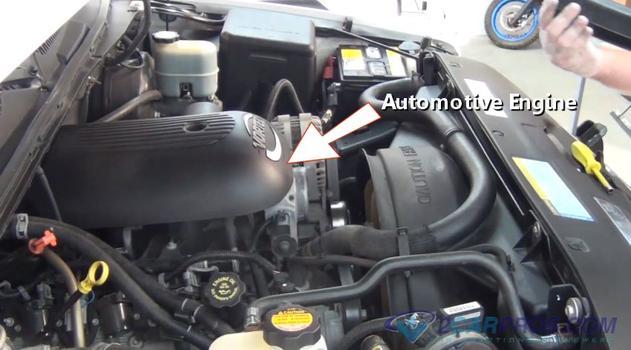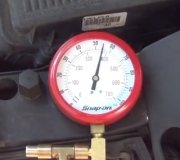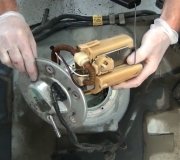Hold on. If everything else is okay, fuel pressure isn't the problem. I was trying to get too far ahead because most people will reply nothing was done with the battery, then we start looking at other things.
When the battery is disconnected or run dead, the memory is lost in the Engine Computer. Later, when the engine is restarted, the computer relearns the personalities of the various sensors, and it starts to rebuild the fuel trim tables right away as you drive, without you even noticing. The one exception is "minimum throttle". Until that is relearned, idle speed will be too low. The engine may not start unless you hold the accelerator pedal down 1/4", (as you found). It won't give you the nice "idle flare-up" to 1500 rpm at start-up, and it will tend to stall at stop signs or when shifting into gear.
The computer needs to see a very specific set of conditions to know that your foot is off the accelerator pedal, then it takes a reading from the throttle position sensor and puts that in memory. From then on, anytime it sees that same voltage, roughly 0.5 volts, it knows it has to be in control of idle speed.
To meet the conditions for that relearn to take place, drive at highway speed with the engine warmed up, then coast for at least seven seconds without touching the pedals.
Coasting from high speed with a closed throttle gives very high intake manifold vacuum. The computer knows the throttle is closed by that. If your foot is on the accelerator pedal, even just a little, the TPS voltage will bounce around due to bumpy roads. Holding perfectly steady, even to the hundredth of a volt, tells the computer your foot is not on the pedal. Tapping the brake pedal during that seven-second coast also aborts the relearn.
For most people, coasting for seven seconds is equivalent to half of an off-ramp, so problems seem to "fix themselves", and they don't know why. Once that relearn has taken place, if you replace the TPS, and the new one reads a lower voltage at closed throttle, the computer will put that new lower value in memory as soon as it sees it.
A totally different way to watch idle speed is with a scanner and viewing the "idle step" number. I have a Chrysler DRB3 for all of my older vehicles, and a DRB2 for my '95 and older models. You can find these on eBay as well as a lot of nice aftermarket scanners. The Engine Computer controls idle speed by running the automatic idle speed motor on the side of the throttle body assembly. That's not a motor with brushes as you normally think of. Instead, it has four coils of wire that get pulsed with varying voltages and polarities. The armature follows the rotating electromagnetic fields. It can rotate up to roughly ten revolutions from one extreme to the other. As it does, it turns a threaded shaft with a pintle valve on the end. As that valve retracts, it opens an air passage around the throttle blade to let in more air. At the same time it increases the number of milliseconds it pulses the injectors open. Increasing air and fuel is how it increases idle speed. This control only occurs until the computer sees a rise in TPS voltage indicating the accelerator pedal is being moved, then it leaves engine speed up to you.
The computer can set the AIS motor to any of 256 steps as necessary, to keep idle speed where it wants it. For a typical, properly-running engine, I find this to be around step 32. For a V-8 engine with a single-cylinder misfire, expect to see it at around step 50. At a Jeep school I attended, the instructor wanted to show us how much control the computer had through that AIS motor. With a running V-8 engine, he unplugged one injector. Idle speed dropped, as expected, the computer saw that, and responded by setting the AIS motor to somewhere near step 50. That got the idle speed back up to normal. He unplugged a second, third, and fourth injector. Each time the computer raised the step number and idle speed stayed correct. At the end he had seven injectors unplugged. Obviously the engine ran very poorly, but it was able to maintain proper idle speed even though it was shaking like crazy, and it had just barely gone past step 200. The AIS valve was only 4/5 of the way open.
The important point to that sad story is with the scanner, we can read the desired idle speed, the actual idle speed, and the current AIS step number to keep that idle speed correct. When minimum throttle has not been relearned, it will sit at step 0 and never change.
When you do the drive cycle with the seven-second coast, it will not work about two or three times out of a hundred. Do it again while holding the brake pedal up with your foot. If that works, the brake light switch is out of adjustment. There's always two, and often three separate switches in that assembly. One is for the brake lights. That part may not be switching on when it shouldn't. That would cause flashing brake lights while driving. Bumpy roads can cause the brake pedal to vibrate, allowing the other parts to turn on briefly. The part in question causes the lock-up torque converter to unlock, (in preparation for coming to a stop, the computer thinks) and it cuts out the cruise control if it's engaged. That part of the switch also aborts the minimum throttle relearn. Holding the brake pedal up will overcome that bouncing, but the proper fix is to reset the brake light switch. For fun, you can even watch the operation of the brake light switch on the scanner. It will be listed with a "Pressed" or "Released". When a customer complains of the cruise control cutting out intermittently, the DRB3 even shows the "Reason for last cutout". You have to be driving when reading that, otherwise it will show the last cause to be "road speed too low" or "ignition switch turned off". When those pop up while driving, it tells you to look for intermittent wiring or electrical problems with the vehicle speed sensor or ignition switch wiring. If the cruise control cuts out at highway speed, and the reason for last cutout is "brake pedal depressed", you would expect to find the switch out of adjustment and the brake pedal was vibrating on bumpy roads.
All of that stuff is related to idle speed. I hope that takes away any mystery. Let me know if there's anything else related to this problem.
Thursday, April 27th, 2023 AT 7:03 PM



